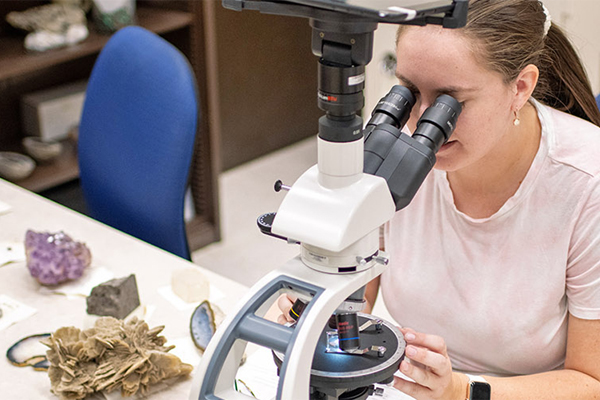Posted on November 14, 2025 by College of Sciences

Elizabeth Bailey, Ph.D., Department of Earth and Planetary Sciences
Please tell us about yourself.
I am an Assistant Professor of Earth and Planetary Science at UT San Antonio and PI of the Early Earth Laboratory (EEL). My research focuses on how the Solar System, including Earth, formed and changed over time. I build computer models and carry out laboratory-based chemical analyses of planetary materials, including meteorites that formed in the Solar System and ancient rocks from Earth.
What did your journey to UT San Antonio look like and are you fixed-term track or tenure track?
I took interest in space from a young age, in large part because I grew up in central Florida and would regularly watch space shuttle launches from my family's driveway. I got my bachelor's degree in mathematics at MIT with the intention to prepare for a career in science. About halfway through college, I discovered that a career in geology was an option, and that you can travel around the world to remote places collecting rocks to solve mysteries about Earth's history. Even better, I learned that a field called planetary science merges geology with astronomy, physics, chemistry, and space missions. I got involved with research, found that I enjoyed it, and went to Caltech to pursue a PhD in planetary science. Upon graduating, I received the 51 Pegasi b Postdoctoral Fellowship in Planetary Astronomy from the Heising-Simons Foundation, which I took to UC Santa Cruz. In my postdoc I branched out from my very theoretical dissertation work into work using laboratory-based techniques to study planetary materials. Earlier this year, I accepted a tenure-track professorship here at UT San Antonio in the Department of Earth and Planetary Sciences.
What do you enjoy most about your area of study?
Planetary science really boggles the imagination. I like to think about what our own planet used to be like billions of years ago, when life looked very different than it is today--and what it would be like to visit another world.
What are some of the most notable research projects that you’ve been involved in?
I recently led a collaboration that demonstrated an approach to use minerals called carbonates as records of redox conditions. This work showed that tiny amounts of iron captured in these minerals can be analyzed with sensitive spectroscopic techniques to characterize past chemical changes in ancient meteorites that were present in the solar system when the planets were forming. This is an exciting result with implications beyond meteorites, because carbonates like calcite and dolomite are found in many planetary settings where liquid water once existed. Previously, these minerals hadn’t been widely considered as redox records. The emergence of a new paleoredox proxy is exciting because redox variations on ancient Earth are often poorly constrained but were highly relevant to the development and evolution of life on our planet.
What do you enjoy most about your job?
I love to share my enthusiasm for scientific inquiry through teaching and mentorship, especially when I get to watch my students and mentees achieve their goals.
How would you spend your ideal Saturday?
My ideal Saturday would be to go on a long trail run, then eat a bunch of really good food and hang out with my partner and my cat.
What are your book recommendations?
Lately I've been listening to David Goggins' audiobooks, and for fiction I am currently reading the Three Body Problem by Liu Cixin.

Explore the EPS Department!
With research centers such as the Center for Advanced Measurement in Extreme Environments and the Institute for Water Research, Sustainability and Policy, students have access to diverse research opportunities to foster their education.
Recent EPS Spotlights
View More Spotlights



